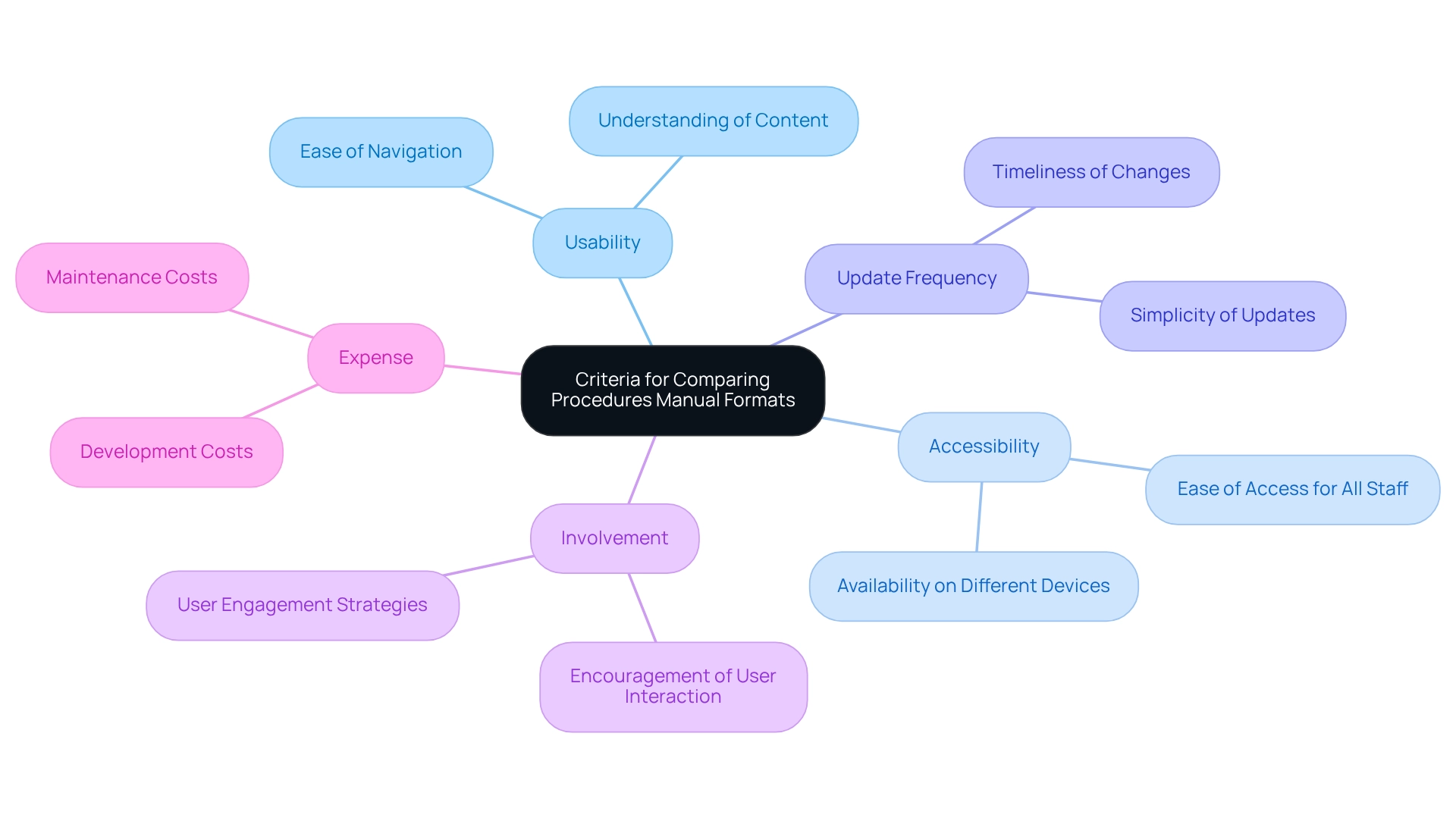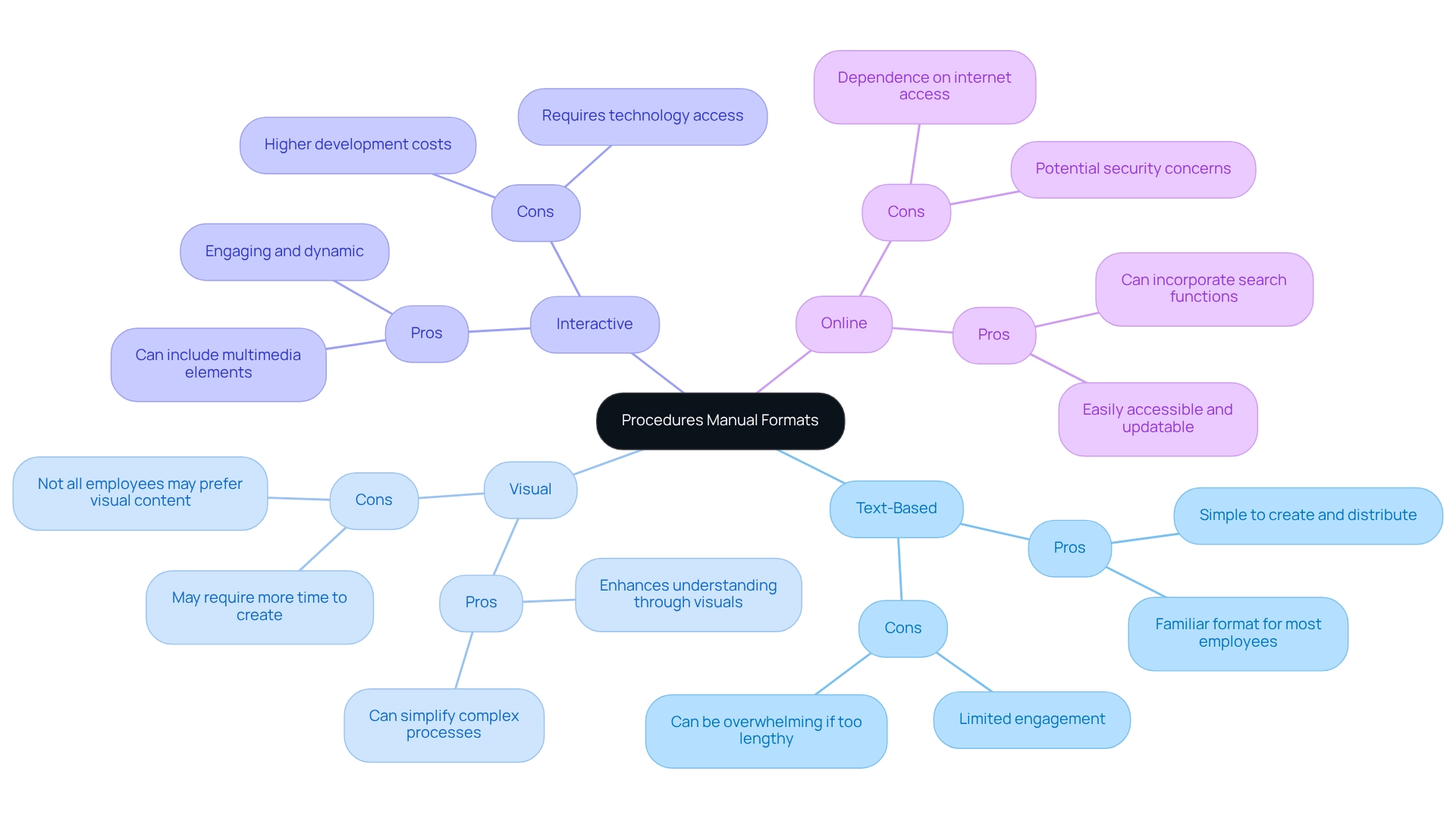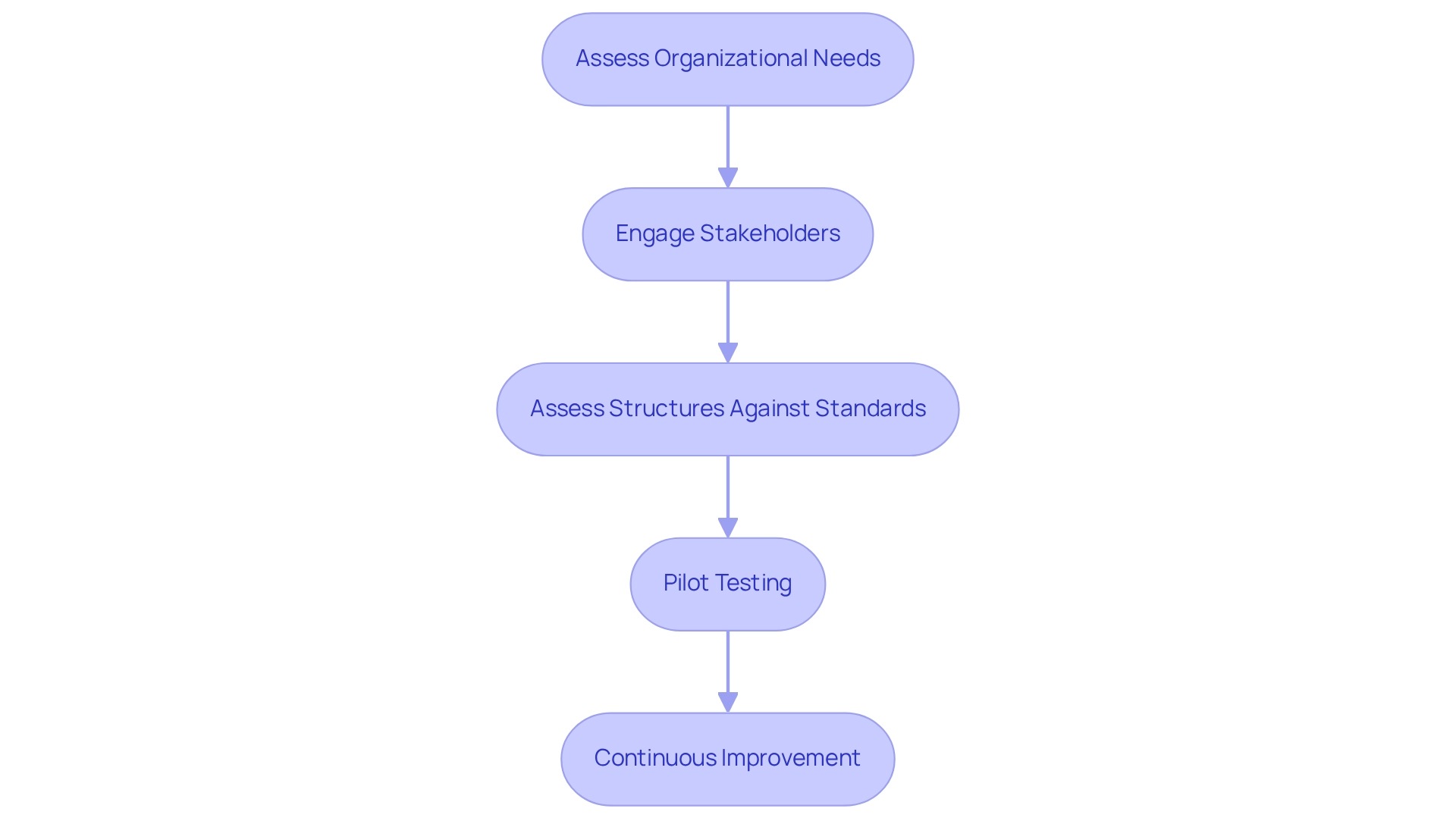
Overview
You might be curious about how different procedures manual formats stack up against each other. This article dives into that very topic, highlighting the key features and benefits that can really boost your organization's efficiency.
So, which format should you go for—text-based, visual, interactive, or digital? It all boils down to usability, accessibility, and what your organization truly needs.
By following some structured guidelines, you can significantly improve compliance and cut down on those pesky operational risks.
Now, let’s explore how the right choice can make a difference!
Key Highlights:
- Procedures manuals are essential documents that outline policies and processes for organizational efficiency.
- Clear guidelines in procedures manuals simplify training, enhance compliance, and reduce operational risks.
- SowFlow streamlines the documentation process, enabling quicker creation of SOPs and training materials.
- Organizations with structured guidelines report a 25% reduction in compliance-related incidents.
- Different formats of procedures manuals include text-based, visual, interactive, and digital guides, each with unique advantages.
- Key criteria for comparing procedures manual formats include usability, accessibility, update frequency, user involvement, and cost.
- Text-based manuals are easy to create but can be overwhelming; visual manuals enhance understanding but may require more time to produce.
- Interactive manuals are engaging but come with higher costs and technology requirements.
- Choosing the right procedures manual format involves assessing organizational needs, engaging stakeholders, and conducting pilot tests.
- Continuous improvement is crucial to ensure the selected format remains effective and aligned with operational goals.
Introduction
In the intricate world of organizational management, have you ever thought about how important a procedures manual really is? This essential document serves as a cornerstone for effective operations, outlining the policies and guidelines that keep daily activities running smoothly. Plus, it plays a key role in ensuring compliance and minimizing risks.
With innovative platforms like SowFlow shaking things up, creating and maintaining these manuals has never been easier. Now, as businesses tackle the complexities of modern operations, understanding the various formats of procedures manuals and their benefits is more crucial than ever.
So, let’s dive into why procedures manuals matter, explore the different formats out there, and discover how to choose the best approach for boosting your organization’s effectiveness.
Understanding Procedures Manuals: Definition and Importance
You might be wondering what an operations guide really is and why it matters. Well, it's a vital document in procedures manual format that outlines the policies, processes, and guidelines essential for your organization to run smoothly. Think of it as a go-to reference for employees, helping them stay in sync with your organization's standards and practices. The significance of having clear guidelines in can't be overstated; they not only simplify training and onboarding but also enhance compliance with regulations and reduce operational risks. By providing straightforward, step-by-step instructions, an operations guide in procedures manual format helps minimize mistakes and discrepancies, which in turn boosts productivity and efficiency.
Now, let’s dive into how SowFlow has changed the game for organizations when it comes to documenting their processes. As Anastasia Masadi, a Product Owner, puts it, "SowFlow has been a game changer in the way we document work and deliver to our clients. I do not have to take each screenshot separately, and do not even have to leave the browser while I am creating SOPs and training materials. SowFlow gave me time from my life back." This really highlights how SowFlow empowers teams to whip up SOPs and training materials in no time, transforming the documentation process and saving precious time. Plus, its features not only ramp up efficiency but also aid in compliance and risk management by ensuring that all documentation is in .
Did you know that organizations with well-organized guidelines see a significant boost in operational efficiency? For instance, those that put detailed guidelines in place report a 25% drop in compliance-related incidents, which really underscores their importance in managing risks. Experts agree that guidelines in a procedures manual format aren't just administrative tools; they're strategic assets that foster a culture of accountability and continuous improvement. Rachael Sherman, Director of Global Sustainability at McDonald's Corporation, shares, "Using the Accountability Framework is like consulting with the entire coalition of stakeholders behind the AFi," which really emphasizes how structured guidelines can help achieve organizational goals.
Real-world examples show that effective guidelines can enhance adherence and lower risks. Take McDonald's and their work with high-risk suppliers; their thorough methods ensure compliance with sustainability policies, ultimately promoting responsible sourcing practices. This case study illustrates how guidelines can lead to tangible results and improve overall performance. In today’s fast-paced business world, integrating the procedures manual format is key to nurturing a culture of accountability and ongoing improvement.
Exploring Different Formats of Procedures Manuals
You might be wondering about the different styles of and how they can benefit you. Well, there are several options, each with its own perks and quirks. Let’s break them down together:
- Text-Based Manuals: These classic documents lay out detailed instructions in writing. They're straightforward to create and can easily be printed or shared online.
- Visual Guides: Think diagrams, flowcharts, and images—visual guides can really boost understanding by showing processes graphically.
- Interactive Manuals: These digital gems let users click around, watch videos, and enjoy animations, making the learning experience much more engaging.
- Digital Guides: Stored on intranets or in the cloud, these guides are super accessible and can be updated on the fly, so everyone’s always in the loop with the latest info.
So, how do you choose the right one? It really depends on your organization's vibe, the complexity of the processes, and the procedures manual format that is most effective for your users. It’s all about finding the right fit for your needs!

Criteria for Comparing Procedures Manual Formats
When considering the comparison of procedures manual formats, there are a few key things to keep in mind, right?
- Usability: How easy is it for your staff to navigate and understand the guide?
- Accessibility: Can everyone easily get to the guide, and is it available on different devices?
- Update Frequency: How simple is it to update the guide when procedures or policies change?
- Involvement: Does the structure encourage user interaction? The more involved they feel, the more likely they are to consult it!
- Expense: What are the costs associated with developing and maintaining the guide in each format?
These criteria really help organizations figure out which procedures manual format fits best with their needs and what their staff prefers. So, you might be wondering how these elements can make a difference in your own documentation process. Let’s dive into that!

Comparative Analysis of Procedures Manual Formats: Pros and Cons
Have you ever considered how various procedures manual formats can truly impact your organization? A comparative analysis reveals some distinct advantages and disadvantages that you should consider when selecting the best approach for your documentation needs:
- Format Type
-
Text-Based Manuals
- Pros:
- Simple to create and distribute
- Familiar format for most employees
- Cons:
- Can be overwhelming if too lengthy
- Limited engagement
- Pros:
-
Visual Manuals
- Pros:
- Enhances understanding through visuals
- Can simplify complex processes
- Using images means that users can see exactly what a process or task is supposed to look like, rather than guessing based on text alone.
- Cons:
- May require more time to create
- Not all employees may prefer visual content
- Pros:
-
Interactive Manuals
- Pros:
- Engaging and dynamic
- Can include multimedia elements
- Cons:
- Higher development costs
- Requires technology access
- Pros:
-
Online Manuals
- Pros:
- Easily accessible and updatable
- Can incorporate search functions
- Cons:
- Dependence on internet access
- Potential security concerns
- Pros:
-
This analysis really highlights how important it is to align the chosen format with your organization's specific needs, available resources, and employee preferences. For instance, while text-based guides are straightforward and familiar, they can become a bit cumbersome if they get too detailed. On the flip side, visual guides can significantly improve understanding, especially in more complex procedures, but they might not resonate with everyone on your team.
Now, let’s dive into interactive guides. They provide a dynamic experience, incorporating multimedia elements that can enhance engagement. However, keep in mind they come with higher development costs and require access to technology. Online guides? They’re great for easy updates and accessibility, especially with SowFlow's instant documentation solution, which makes revisions effortless and keeps content relevant in a fast-paced business world. Just remember, they do depend on reliable internet access and could raise some security concerns.
Moreover, a well-designed training document can actually help companies save money by being applicable to various staff members. This really emphasizes the efficiency of operational guides in financial management, and ultimately, the success of your procedures manual format hinges on its ability to enhance comprehension and usability among your staff. It’s essential for organizations to assess their specific contexts and worker preferences when making a choice. Take, for example, the case study on color coding for better communication. This illustrates how visual elements can speed up communication and decision-making, especially in fast-paced manufacturing environments. And guess what? SowFlow's solutions can help teams implement effectively. Plus, materials for integrating new staff highlight just how crucial guidelines are in optimizing training processes, showing how SowFlow's solutions can give teams immediate access to vital documentation.

Choosing the Right Procedures Manual Format for Your Organization
Are you considering the right procedures manual format? It’s not just a checkbox on your to-do list—it's a journey! Here are some friendly steps to guide you through:\n\n1. Assess Organizational Needs: First off, take a moment to understand what your organization really needs. What’s the complexity of your procedures? And how tech-savvy is your team?\n2. Engage Stakeholders: You might be wondering, how can I make this process better? Involve your employees! Their insights can be invaluable when it comes to understanding preferences and needs.\n3. Assess Structures Against Standards: Speaking of standards, use those established benchmarks to compare different structures. Which one aligns best with what your organization aims to achieve?\n4. Pilot Testing: Now, let’s dive into pilot testing! Consider launching a trial with a small group of users. Their feedback on the layout can be crucial before you go all-in.\n5. Continuous Improvement: After you roll it out, don’t just set it and forget it! Continue to assess and revise the guide based on user feedback and any changes in processes to ensure that the procedures manual format you select enhances efficiency and supports . So, ready to enhance your documentation game?

Conclusion
You know, the importance of a procedures manual in organizational management really can’t be overstated. It’s like the backbone of your operations, laying out all those essential policies and guidelines that keep everything running smoothly. Think about it: it streamlines training, ensures compliance, and helps mitigate risks. And with innovative tools like SowFlow, creating and maintaining these manuals is easier than ever, which ultimately boosts productivity and fosters a culture of accountability.
Now, when you dive into the different formats of procedures manuals, you’ll find each one has its own set of perks and challenges. Whether you’re leaning towards text-based, visual, interactive, or online manuals, it’s crucial to assess your specific needs and what your employees prefer. This comparative analysis really shines a light on the importance of usability, accessibility, and engagement. The right format can make a world of difference in how efficiently your operations run.
So, as you wrap your head around choosing the right format for your procedures manual, remember it’s a strategic choice that deserves some thoughtful consideration. You’ll want to factor in your organizational goals and gather feedback from your team. By taking a structured approach to selection and implementation, you can ensure that your procedures manuals are not just vital resources but also catalysts for continuous improvement and long-term success. Prioritizing the development of a well-crafted procedures manual will empower your teams and elevate overall organizational effectiveness, making it an indispensable asset in today’s fast-paced business world.
Frequently Asked Questions
What is an operations guide and why is it important?
An operations guide is a vital document in procedures manual format that outlines the policies, processes, and guidelines essential for an organization to operate smoothly. It serves as a reference for employees, helping them align with organizational standards, simplify training and onboarding, enhance compliance with regulations, and reduce operational risks.
How does an operations guide improve productivity and efficiency?
By providing clear, step-by-step instructions, an operations guide helps minimize mistakes and discrepancies, which boosts productivity and efficiency within the organization.
How has SowFlow changed the documentation process for organizations?
SowFlow has transformed the way organizations document work by allowing users to create Standard Operating Procedures (SOPs) and training materials without needing to take separate screenshots or leave the browser. This streamlines the documentation process and saves time.
What impact do well-organized guidelines have on operational efficiency?
Organizations with detailed guidelines report a significant boost in operational efficiency, including a 25% drop in compliance-related incidents, highlighting their importance in managing risks.
What are some examples of how structured guidelines can lead to positive outcomes?
Effective guidelines can enhance adherence and lower risks, as demonstrated by McDonald's work with high-risk suppliers, where thorough methods ensure compliance with sustainability policies, promoting responsible sourcing practices.
What are the different styles of procedures manual format?
There are several styles, including: 1. Text-Based Manuals: Detailed written instructions that are easy to create and share. 2. Visual Guides: Diagrams, flowcharts, and images that enhance understanding. 3. Interactive Manuals: Digital formats that allow users to engage with content through clicks, videos, and animations. 4. Digital Guides: Stored on intranets or in the cloud, these are easily accessible and can be updated quickly.
How do I choose the right procedures manual format for my organization?
The choice depends on your organization's culture, the complexity of the processes, and which procedures manual format is most effective for your users. It's about finding the right fit for your needs.
👍
What others are liking
5 Steps to outline your ideal documentation structure
5 MINS READ
Where to start the your journey of mapping out your ideal documentation structure, aligning it with the very heartbeat of your organization?
Defining a winning level of detail in your process
3 MINS READ
What is too much detail, and what is too little? This article described in that winning level detail about what detail is enough.





